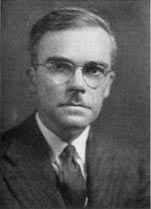Edward L. Norton
Created and Claimed by yyang414 (Yuchen Kenneth Yang). PHYS 2212.

Early Years and Career
Edward Lawry Norton was born in Rockland, Maine on July 28th, 1898. He was known as an American electrical engineer whom the Norton equivalent circuit is named. In his early career, Norton served as a radio operator in the United States Navy between the years of 1917 to 1919. He attended the University of Maine for one year before and for one year after his wartime service, then transferred to MIT in 1920 to obtain his B.S. in electrical engineering in 1922. Afterwards, he began to work at the Western Electric Corporation in New York City, which eventually became Bell Laboratories in 1925. While working for Western Electric, he earned an MA degree in electrical engineering from Columbia University in 1925.
Publications and Research
Among his publications are constant resistance networks with applications to filter groups in the Bell System Technical Journal, magnetic fluxmeter in the Bell Laboratories Record and dynamic measurements on electromagnetic devices in the Transactions of the AIEE. Norton wrote 92 technical memoranda (TMs in Bell Laboratories parlance). Because of Norton's lack of publications, it appears that Norton preferred working behind the scenes. As described in the history of Bell Labs, "this reticence belied his capabilities."
Telegraph
Norton was something of a legendary figure in network theory work who turned out a prodigious number of designs armed only with a slide rule and his intuition. Many anecdotes survive. On one occasion T.C. Fry called in his network theory group, which included at that time Bode, Darlington and R.L. Dietzold among others, and told them: "You fellows had better not sign up for any graduate courses or other outside work this coming year because you are going to take over the network design that Ed Norton has been doing single-handed." [A History of Engineering and Science in the Bell System: Transmission Technology (1925-1975), p. 210]
Magnetic Maps and Electrodynamics
He applied his deep knowledge of circuit analysis to many fields, and after World War II he worked on Nike missile guidance systems. On November 11, 1926, he wrote the technical memorandum Design of Finite Networks for Uniform Frequency Characteristic, that contains the following paragraph on page 9: "The illustrative example considered above gives the solution for the ratio of the input to output current, since this seems to be of more practical interest. An electric network usually requires the solution for the case of a constant voltage in series with an output impedance connected to the input of the network. This condition would require the equations of the voltage divided by the current in the load to be treated as above. It is ordinarily easier, however, to make use of a simple theorem which can be easily proved, that the effect of a constant voltage E in series with an impedance Z and the network is the same as a current I=E/Z into a parallel combination of the network and the impedance Z. If, as is usually the case, Z is a pure resistance, the solution of this case reduces to the case treated above for the ratio of the two currents, with the additional complication of a resistance shunted across the input terminals of the network. If Z is not a resistance the method still applies, but here the variation of the input current E/Z must be taken into account."

This paragraph clearly defines what is now known as the Norton equivalent circuit in the United States. Norton never published this result or mentioned it in any of his 18 patents and 3 publications. In Europe, it is known as the Mayer-Norton equivalent. The German telecommunications engineer Hans Ferdinand Mayer published the same result in the same month as Norton's technical memorandum. Norton retired in 1961 and died on January 28, 1983 at the King James Nursing Home in Chatham, New Jersey.
Further sources
https://www.youtube.com/watch?v=cFKONUBBHQw
The World’s First Transatlantic Telegraph Cable
References
http://www.ece.rice.edu/~dhj/norton/
http://eleceng.adelaide.edu.au/about/history/famous-scientists/